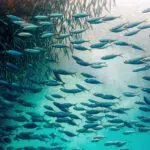World Fish Migration Day on May 21 takes place every alternate year. This event is a global celebration that creates awareness about the importance of migratory fish and free-flowing rivers. On this day, orinthological organizations all over the world, coordinate their events around the common theme of ‘Connecting Fish, Rivers, and People.’ The day seeks to improve the public understanding of the importance of migratory fish. It also encourages citizens to take action toward the protection of freshwater fish.
History of World Fish Migration Day
Many varieties of fish migrate for reproduction, feeding, and life-cycle completion. These creatures serve as a crucial link in the food chain and play a vital role in creating productive and healthy river systems. They are also central to the livelihoods of millions of people around the world. Migratory fish are ecologically, economically, culturally, as well as recreationally significant. However, many varieties are ecologically threatened or critically endangered today. That’s why environmental conservationists created this day to make people aware of the importance of rivers and fish migration.
Environmentalists aim for feasible solutions in the areas of fish-migration restoration, river recovery, and degradation prevention. If left unattended, these issues will further push the migratory fish towards extinction. To achieve this goal, educating others and raising awareness about the current situation is a good place to start. On World Fish Migration Day, experts and stakeholders discover and implement solutions to the challenge. Migratory fish swim over short or long distances at different intervals. They migrate up and down the rivers, between rivers and oceans, or across the oceans. The routes that they follow are known as swimways and span thousands of miles through different water bodies.
Dams are one of the biggest threats to swimways as they tend to cut off the migration routes, which prevents fish from reaching their feeding and breeding grounds. The World Fish Migration Foundation has currently undertaken a project to map fish migration routes and identify hotspots. This will lead to informed decision-making to lessen the impact of infrastructure development on migratory fish. The first World Fish Migration Day was held in 2014, with events in over 40 countries. The celebration has since grown over the years to reach millions of people through various media.
World Fish Migration Day timeline
A prehistoric bas-relief carving of an Atlantic salmon is discovered in the French Abri du Poisson, or Fish Rock Shelter.
The General Court of the Massachusetts Bay Colony bans the use of striped bass to fertilize crops.
Construction of the Great Stone Dam on the Merrimack River, U.K., eliminates Atlantic salmon from the watershed.
Resource managers in the U.K. begin building fishways to allow fish to pass over dams and other obstructions — this also leads to the formation of the Division of Fisheries and Wildlife.
World Fish Migration Day FAQs
What are some examples of migratory fish?
Salmon, freshwater eels, sea trout, allis shad, Mekong giant catfish, American paddlefish, and bull sharks are a few examples of fish that migrate.
What are the hashtags for World Fish Migration Day?
The social media hashtags for this day are #WorldFishMigrationDay, #HappyFish, and #BreakFree.
What types of events are held for World Fish Migration Day?
Some key events include aquarium/museum exhibits and field trips, river cleanups, kayak trips, movie screenings, citizen science labs, global webinars, and many more.
How to Observe World Fish Migration Day
Educate yourself and others
This holiday is a chance to learn about the current local freshwater policies and see if they advocate for free-flowing rivers. You can also watch some documentaries on migratory fish to expand your knowledge about these issues.
Host or attend an event
A befitting way to mark this day is by hosting a World Fish Migration Day event in your community to educate the public about the importance of migratory fish and free-flowing rivers. If that’s not possible, check out if there is a World Fish Migration Day event in your vicinity that you can attend, or simply offer to volunteer.
Reduce your impact
Be more conscious of the products you use in your household that can harm waterways and fish. If possible, switch to environment-friendly products. Also, learn where your electricity comes from, and try to opt for renewable energy sources.
5 Interesting Facts About Fish
Diadromous fish
Sea-run fish are called diadromous because they live part of their lives in saltwater and part in freshwater.
A fish without bones
Just like sharks, Atlantic sturgeon are cartilaginous too; their skeleton consists mostly of cartilage, not bones.
Different Lifespans
Atlantic sturgeon can live up to six decades in Canada, but only up to three in the Southeast.
Maryland’s state fish
The striped bass, also known as the Atlantic striped bass, striper, linesider, rock, or rockfish, is Maryland's state fish.
Freeze-proof fish
Rainbow smelt fish don’t freeze due to proteins and glycerol in their blood, liver, muscle, and other tissues, which prevent freezing even in temps as low as 28°F.
Why World Fish Migration Day is Important
Environmental protection
Sometimes conservation feels like an unattainable goal. However, raising awareness is an essential first step toward real change.
It’s educational
There are so many interesting things about migrating fish that we get to learn on World Fish Migration Day. From the types of migratory fish, to how they navigate long distances in the water, there’s no dearth of mind-blowing facts.
It’s family-friendly
Family-friendly holidays provide a good opportunity to bond with loved ones. World Fish Migration Day is an excellent opportunity to get together and contribute to the greater good of the planet.
World Fish Migration Day dates
| Year | Date | Day |
|---|---|---|
| 2026 | May 21 | Thursday |
| 2027 | May 21 | Friday |
| 2028 | May 21 | Sunday |
| 2029 | May 21 | Monday |
| 2030 | May 21 | Tuesday |





















